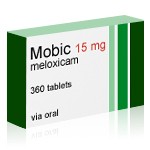Joint and Nerve Pain: Osteoarthrosis and Radiculitis Explained


Pain is often the most disabling symptom for individuals suffering from musculoskeletal and neurological disorders. Among these, osteoarthrosis and radiculitis are two common but distinct conditions, each associated with unique pain syndromes. While osteoarthrosis involves joint degeneration, radiculitis refers to inflammation of spinal nerve roots, often resulting in radicular pain — a pain that radiates along the path of a nerve. Understanding the underlying mechanisms and clinical manifestations of these conditions is essential for effective diagnosis and treatment. This article explores the nature of pain in osteoarthrosis and radiculitis, clarifies related neurological terms, and highlights the role of anti-inflammatory drugs like Mobic (meloxicam) in alleviating symptoms.
Understanding Osteoarthrosis and Its Pain Syndrome
Osteoarthrosis, also known as osteoarthritis (OA), is a degenerative joint disease that primarily affects cartilage, the smooth tissue covering the ends of bones in a joint. As the cartilage wears away over time, bones begin to rub against each other, leading to pain, stiffness, reduced mobility, and in some cases, inflammation. The disease typically affects weight-bearing joints such as the knees, hips, and spine, but can also impact the hands and shoulders.
The pain in osteoarthrosis is mechanical in nature, meaning it tends to worsen with physical activity and improve with rest. Initially, the discomfort may be mild and sporadic, but as the disease progresses, it can become constant and more intense, often interfering with daily activities. This pain is usually localized to the affected joint, though in spinal osteoarthrosis, the degeneration of intervertebral discs and the formation of bone spurs can lead to nerve root compression, resulting in radicular symptoms.
What Is Radicular Pain Syndrome?
Radicular pain syndrome refers to a group of symptoms that occur when a spinal nerve root becomes compressed or inflamed. The term "radicular" is derived from "radix," the Latin word for root. This type of pain is different from localized joint pain — it radiates from the spine outward along the distribution of the affected nerve. For example, a compressed lumbar nerve root may produce pain that shoots down the leg (sciatica), while cervical nerve root involvement can lead to pain radiating into the shoulder and arm.
Radicular pain is typically sharp, shooting, or burning in quality, and may be accompanied by tingling, numbness, or muscle weakness in the affected limb. The location and nature of the pain help physicians identify which nerve root is involved. It is a hallmark symptom of radiculitis and radiculopathy, conditions that are often confused but differ in important ways.
What Is a Common Cause of Radiculitis?
Radiculitis is the inflammation of one or more spinal nerve roots. The most frequent cause is mechanical compression, usually resulting from a herniated disc, spinal stenosis (narrowing of the spinal canal), or bone spurs associated with osteoarthrosis. These conditions place pressure on the nerve root, triggering inflammation and pain. However, radiculitis can also result from infections such as shingles (herpes zoster), autoimmune diseases, or even metabolic conditions like diabetes.
The inflammatory nature of radiculitis distinguishes it from purely mechanical nerve root compression. Inflammation can cause hypersensitivity of nerve fibers, leading to exaggerated pain responses even to light touch. This heightened pain perception is often referred to as hyperalgesia or allodynia.
What Is Painful Sensory Radiculitis?
Painful sensory radiculitis specifically involves inflammation of sensory nerve roots, which carry sensory information from the periphery to the central nervous system. This type of radiculitis is characterized by intense neuropathic pain without significant motor involvement. Patients may describe the pain as burning, stabbing, or electric shock-like. Sensory radiculitis can be particularly distressing and difficult to manage, often leading to sleep disturbances, mood changes, and decreased quality of life.
In some cases, sensory radiculitis may be idiopathic (of unknown origin) or linked to systemic diseases like Lyme disease or autoimmune disorders. Diagnostic tests such as MRI and nerve conduction studies are often used to confirm inflammation and rule out structural causes.
Radiculitis vs. Radiculopathy: What Is the Difference?
Although the terms "radiculitis" and "radiculopathy" are often used interchangeably, they denote different conditions. Radiculitis refers strictly to inflammation of the nerve root and is primarily associated with pain. The primary complaint is usually radicular pain, and neurological deficits may be minimal or absent.
Radiculopathy, on the other hand, involves any disease or dysfunction of the nerve root, which can include compression, degeneration, or trauma. It is a broader term encompassing both inflammatory and non-inflammatory causes. Radiculopathy often presents with a combination of sensory and motor symptoms, including numbness, tingling, muscle weakness, and reduced reflexes in the distribution of the affected nerve.
In short, radiculitis is more pain-centric and inflammatory, while radiculopathy may reflect a more advanced or chronic state with structural nerve damage.
The Intersection of Osteoarthrosis and Radicular Pain
Osteoarthrosis of the spine—especially in the lumbar and cervical regions — is a frequent contributor to radicular pain. Degeneration of intervertebral discs and formation of osteophytes (bone spurs) can lead to narrowing of the spinal foramina, the channels through which nerve roots exit the spine. This process can result in both mechanical compression and inflammatory changes in nerve roots, thereby causing radiculitis or radiculopathy.
Patients with spinal osteoarthrosis often experience a mixed pain syndrome. They may have localized axial pain from joint degeneration as well as radiating pain due to nerve root involvement. This combination makes diagnosis and treatment more complex, often requiring a multimodal therapeutic approach.
The Role of Mobic (Meloxicam) in Treatment
Managing pain in patients with osteoarthrosis and radiculitis requires a strategy that addresses both inflammation and the underlying structural causes. Mobic, the brand name for meloxicam, is a nonsteroidal anti-inflammatory drug (NSAID) widely used in the treatment of musculoskeletal disorders. It is particularly effective for patients with both joint degeneration and inflammatory pain.
Meloxicam works by inhibiting cyclooxygenase (COX) enzymes — primarily COX-2 — which are responsible for the production of prostaglandins, chemical mediators that promote inflammation, pain, and fever. By reducing prostaglandin synthesis, Mobic helps alleviate both the joint pain of osteoarthrosis and the radicular pain associated with nerve root inflammation.
Unlike some other NSAIDs, meloxicam has a relatively favorable gastrointestinal safety profile when used at recommended doses, making it a suitable long-term option for chronic conditions. It is available in oral tablet form and is typically taken once daily, providing sustained relief throughout the day.
Clinical studies have shown that meloxicam can significantly improve pain scores, reduce stiffness, and enhance functional mobility in patients with osteoarthrosis. In radiculitis, it may help reduce nerve root inflammation and dampen the associated neuropathic pain, especially when combined with physical therapy and other supportive measures.
Additional Considerations in Pain Management
While NSAIDs like Mobic are effective in many cases, they are often used in conjunction with other treatments. Physical therapy is crucial for maintaining joint flexibility and spinal alignment. In cases of severe nerve root compression, corticosteroid injections or even surgical interventions may be necessary.
Neuropathic pain from sensory radiculitis may not respond fully to NSAIDs alone. In such cases, medications like gabapentin, pregabalin, or tricyclic antidepressants may be added to target nerve pain more directly.
Lifestyle modifications, including weight loss, posture correction, and ergonomic adjustments, also play an essential role in reducing mechanical stress on joints and the spine, thus helping to prevent symptom flare-ups.
Conclusion
Pain syndromes in osteoarthrosis and radiculitis are complex, often overlapping conditions that require a comprehensive and nuanced approach. Understanding the difference between localized joint pain and radicular nerve pain is critical for proper diagnosis and effective treatment. While radiculitis is rooted in nerve inflammation, osteoarthrosis involves progressive joint degeneration, yet both can contribute to debilitating pain.
Mobic (meloxicam) serves as an effective pharmacological tool to reduce inflammation and pain in both conditions. By targeting the underlying inflammatory processes, it provides symptom relief and supports improved quality of life. However, optimal management often involves a multidisciplinary approach, combining medication with physical therapy, lifestyle changes, and sometimes interventional procedures. Early recognition and targeted treatment can help patients regain function, reduce pain, and return to a more active life.
Aricle Post:Editorial Team of RXShop.md
(Updated at Jul 26 / 2025)

